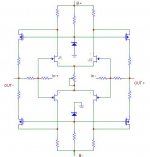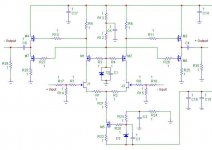Line level or speakers cables?
I would be worried about the slave amps accuracy and speed... if you used the same amp with identical loading... I guess it could work out pretty nicely...
I am still working on my liquid speaker cables... I am using pumps now to speed up the signals.

I would be worried about the slave amps accuracy and speed... if you used the same amp with identical loading... I guess it could work out pretty nicely...
I am still working on my liquid speaker cables... I am using pumps now to speed up the signals.

GRollins said:...Jam,
If the same schematic is posted here, then by all means post a link to the appropriate thread.
There's a thread on the other site that is quite enlightening. Again--I have serious reservations about some of the things that happen here, but there's a right way and a wrong way to go about things...
Grey
Dear Grey,
please accept my sincere apologies for linking to a politically incorrect site

Here you are:
Uli



Attachments
Gainblock ULI
Hi Uli,
Nice variation of the blowtorch principle.
That loop around the 22k resistors what's that?
A dc-offset regulation?
Did you make a live version of this pre-amp or only simulations?
Gr.
Johan.
Hi Uli,
Nice variation of the blowtorch principle.
That loop around the 22k resistors what's that?
A dc-offset regulation?
Did you make a live version of this pre-amp or only simulations?
Gr.
Johan.
Johan,
Its not a variation of the "Blowtorch Principle" (when I did this
circuit, I didnt even know Mr. Curl😉 ). It is more inspired by Mr.
Pass´ Supersymmetry Patent and the work of Erno Borbely. This
particular circuit (with kind of discrete servo around the 2SJ109)
is just an idea. Jam influenced me to redesign a working circuit,
similar but not complementary, with opamp servo, folded
cascode, X Feedback, active CCSes instead of a mirror resistor in
the folded cascode.
There are lots of variations of the idea to use both legs of a diff
amp: Pass, Curl, Borbely, Hansen et al.
Uli



Its not a variation of the "Blowtorch Principle" (when I did this
circuit, I didnt even know Mr. Curl😉 ). It is more inspired by Mr.
Pass´ Supersymmetry Patent and the work of Erno Borbely. This
particular circuit (with kind of discrete servo around the 2SJ109)
is just an idea. Jam influenced me to redesign a working circuit,
similar but not complementary, with opamp servo, folded
cascode, X Feedback, active CCSes instead of a mirror resistor in
the folded cascode.
There are lots of variations of the idea to use both legs of a diff
amp: Pass, Curl, Borbely, Hansen et al.
Uli



You are correct Uli. There are only so many ways to make a circuit, and many will look similar. It is the same with auto engines. Could you tell the important differences between them with just a picture?
The important thing is to make the most linear circuitry possible, so that feedback is not very important or even can be reduced to almost nothing. This seems to make audio circuits sound better. This is true with tubes, transistors, or fets.
In general, tubes are the most linear individual active devices, followed by fets, and then bipolar transistors. The problem with tube circuits is that they have to be coupled between stages with caps or transformers. Solid state circuits can be direct coupled, but they are always prone to more nonlinearity, both static (from Gm variation) and dynamic (from nonlinear capacitance with voltage). This is where solid state circuits can be optimized more than is typically employed, by consideration of the non-linear capacitance and its minimization.
The important thing is to make the most linear circuitry possible, so that feedback is not very important or even can be reduced to almost nothing. This seems to make audio circuits sound better. This is true with tubes, transistors, or fets.
In general, tubes are the most linear individual active devices, followed by fets, and then bipolar transistors. The problem with tube circuits is that they have to be coupled between stages with caps or transformers. Solid state circuits can be direct coupled, but they are always prone to more nonlinearity, both static (from Gm variation) and dynamic (from nonlinear capacitance with voltage). This is where solid state circuits can be optimized more than is typically employed, by consideration of the non-linear capacitance and its minimization.
Whats wrong with feedback in general?
It can be proven mathematically that feedback improves stability, bandwidth and linearity of the system, its one of the corner stones of automatic control theory, why doesnt it work with audio ? Sure inhereted linearity is better but why? opamps use feedback at their max and it doesnt do them any worse.
It can be proven mathematically that feedback improves stability, bandwidth and linearity of the system, its one of the corner stones of automatic control theory, why doesnt it work with audio ? Sure inhereted linearity is better but why? opamps use feedback at their max and it doesnt do them any worse.
VEC7OR, whilst I appreciate your question, there are probably more appropriate threads to discuss it in.
Negative feedback causes a number of secondary problems, such as: TIM, IIM, FIM distortions, that the ear appears able to easily detect. Please understand: I have designed with negative feedback for the last 40 years. It is just that I have found that, all else being equal, less negative feedback is better sounding than more negative feedback.
- Status
- Not open for further replies.
- Home
- Amplifiers
- Solid State
- John Curl's Blowtorch preamplifier


